Home | Saltwater Flies | Fly Tying Materials | Fly Lines & Accessories
Ordering Instructions, Shipping rates, Your Satisfaction Guaranteed | Site Map
Saltwater Flies, Saltwater Fly Reels, Saltwater Fly Rods, REVIEWS!
The Reel in Review

The Islander "FR" #2 - no longer in production, but a pretty nice reel "back in the day".
A review of a few selected saltwater fly reels, and a no-nonsense look at choosing a decent one. Original article posted January 30, 2014. Updated February 12th & 21st, April 24.
I'm often asked my opinion about fly reels and fly rods. Which one is the best? Or, what's the best rod or reel for this kind of fishing? Ultimately you should try to become the best judge of what gear works well for you. If the tackle fits your needs, performs well, feels good (and maybe looks good too), and is durable and trouble-free, then that gear should help you enjoy your fishing, and maybe even make some really exciting catches.
Let me preface this discussion by stating quite clearly and for the record that I am in no way an authority on saltwater fly reels - I have no special mechanical or technical expertise whatsoever regarding the design and construction of fly reels - but I have spent a fair amount of time fishing with them, maintaning them, and occasionally fixing them. Many fly reels that have served me well over the years and that I enjoy fishing with have found a permanent home in my tackle kit - and there were also plenty that ultimately that didn't make the cut for one reason or another. If you are shopping for a reel for a specific situation, seek out friends, peers, or experts who have done a lot of that kind of fishing, and ask their advice. Want a solid tarpon reel? A good tarpon guide can tell you what works for him, and you may quickly learn a lot more about that specific kind of situation than you will learn here. Even among experienced anglers or professionals though, there is likely to be disagreement on what makes a good saltwater fly reel. Some strong opinions may be expressed below, and there are plenty of pretty good anglers who are likely to disagree with me on parts of this discussion, but so be it - let's dive right in.
The Good, the Bad, and the Ugly
Fly rods are a part of our tackle system that can be especially difficult to judge objectively, because an action that suits one angler well may be considered a total dud by another angler. Reels may be a bit easier, but personal preference still plays a role in the tackle we choose, especially when it comes to external appearances. One angler may like brightly colored designs or ones with modern or artistic finishes, while another may prefer a more traditional look. Any angler probably has some idea of how they'd like their fly reels to look, but finding a reel that feels right, and understanding how it is likely to perform in on-the-water fishing situations is another matter. I have developed my own preferences when it comes to the design features of saltwater fly reels. I have a fondness for quality fly reels, and while hardly a collector, I always have a keen eye out for something special that I think I will enjoy fishing with. Let me state here that if you have already been saltwater fly fishing for a number of years, and have been in the practice of maintaining your stuff, then you're probably not going to find any earth-shattering revelations in this discussion. But if you enjoy checking out fly reels, or are just getting started in saltwater fly fishing, then perhaps you should read on. A little further along I will take the time to review a few classic saltwater fly reels, a discussion that may interest anyone who enjoys such things.
Tolerance is a Virtue
Initial build quality is a pretty big part of what determines how well a fly reel will perform in real fishing situations, and also how it will continue to perform over time. The moving parts of a fly reel should fit together neatly, with little if any "slop" or wiggle room between them. Same goes for the spool and the frame. I don't like reels with spools that one can wiggle too much - this is not a good sign. Some tiny degree of space is necessary to allow the spool to turn smoothly, but too much slop can eventually lead to increased wear on the shaft, spool or bearings. Another common spot where one may find a lot of slop is in the handle - I don't like to see too much of it there either. Most high quality classic reels (and the best newer models) have nice close tolerances. Cheaply made reels typically show much poorer tolerances, whether made today, or twenty years ago. Precise manufacturing leads to better performance - and of course higher price tags. Reels with poor tolerances will tend to become less smooth over time, and may develop problems with wear or failure of some of the parts - that brings us to the next part of our discussion - "smoothness".
My friends call me "Smoooooth"
Good saltwater fly reels should feel smooth in their operation, and the spool should turn easily in either direction. Of course it will not be easy to turn in the outgoing direction with the drag engaged, but it should still turn smoothly. Most fly reels - especially when they are new - will feel nice and smooth, but it still pays to check any reel - new or used - to make sure it is working properly. Back the drag off to a low setting to check the movement of the spool. Overall, the reel spool should turn easily, in either direction without any hitches. If you give the spool a good spin and allow it to freespool, it should probably make a few easy turns under its own inertia. Good smoothness overall results from close tolerances, quality bearings that are correctly lubricated and in good condition, as well as a shaft, spool, and frame that are all "true" to their original manufacture. Almost all reels with even a fair degree of quality will have a counter-balance weight attached to the spool opposite the handle. This feature
is quite necessary on any reel that will be used for fast-running fish, as a spool that
is not balanced correctly can have a tendency to "wobble" at high speeds. Spools without
the proper balancing are pretty damn rare these days.
On inexpensive or worn-out reels, a loose or bent shaft can also result in a wobbling spool. A bent or loose shaft can sometimes be tightened or repaired. Loose or bent shafts, as well as bent frames and "dinged" or dented spools can sometimes result in a spot where the spool and frame touch slightly, which will feel like a hitch, hesitation, or roughness when the spool is turned. Under the extreme pressure of a large or very fast fish, a reel with these types of conditions can even "freeze up", which is sure to result in the loss of what should have been a great fish. The most common cause of a bent frame or dinged spool is a sharp impact against an unforgiving surface. This condition can be very difficult to repair. If this happens to a reel that you own, it may be possible to sand or file the spool or the frame lightly to allow clearance so that the spool and frame don't "hang up", but this will affect the finish of the reel, making it more prone to corrosion in that spot. Years ago, as a fishing bum on a budget, I once purchased a pretty expensive fly reel at a yard sale that had a spool with a spot on the rim which was slightly dented, which caused the spool to contact the frame when it was turning. I only paid five bucks for it because of that "rough spot", which I was able to fix, and I caught plenty of fish with that reel once the problem was addressed. Even so, I much prefer to fish with reels that have never sustained this kind of damage. Check any new or used reel that you buy to be sure that the spool doesn't bind or wobble. Store your reels in their cases when not in use. Given reasonable care, a quality reel will stand up to a fair amount of abuse, and will stay smooth for a long time to come - provided you spend a little time occasionally on maintenance - more on that later.
What a Drag
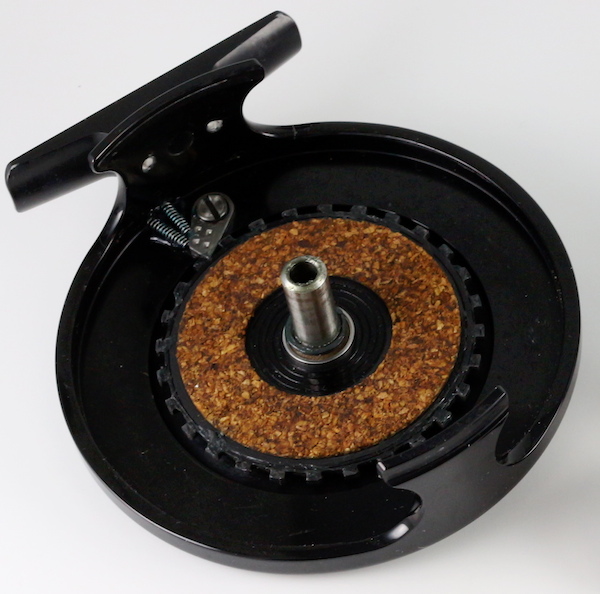
The cork disc drag inside an Abel Big Game 3N reel.
There's plenty of debate about which drag designs are best - I personally have only limited experience with some of the "sealed" drag designs that are common on
newer reels these days - I am most familar with the classic "disc drag plate" systems commonly used in high-quality classic saltwater fly reels like the Abel, the Billy Pate, Tibor, and others. This very reliable design usually features a disc shaped drag plate with a drag surface that is in contact with the reel spool, and the pressure of the drag is altered by turning a knob on the front or back side of the reel. The surfaces of most of these drags are made of cork, but least one reel that I fished with years ago (the Penn 2.5G) had a synthetic drag surface (this reel had quite a decent drag, with the advantage that the drag surface seemed nearly impervious to damage when compared with a natural cork surface). Most of these disc drag designs work well, are easy to inspect and maintain, and will last for many years. They are also mostly quite smooth when a fish is taking line. In my opinion, a larger diameter drag surface is better. Total drag surface is important, but I have come to prefer a reel with larger diameter drag surface, even if there's less total surface overall. Smaller diameter drags will require a somewhat greater "startup inertia" before the spool starts turning when a fish runs - if this startup inertia is too great, it can lead to spool overrun. This issue has been hashed over in countless other articles over the years, and these days this sort of situation really is quite rare - with the excellent build quality found in most saltwater fly reels, there's hardly reason to worry about it anymore.
I like reels that have a large "range" of drag. That means that the amount of drag does not change dramatically with small adjustments of the drag knob. Also, it should change incrementally, so that each turn of the drag knob results in a similar increase or decrease of the drag tension. Plenty of (but not all) high-quality reels have a large range of drag. Some pretty pricy high-end reels have a bit of "fall-off" at light drag tensions, where they will sort of "let go" and start to free spool before one thinks they should. Fly reel drags are rarely set that lightly for actual fishing situations though, so perhaps that particular condition doesn't matter that much, unless you are fishing
with extremely light tippets. Some reels have the opposite problem - the drag becomes too tight with small adjustments of the knob - that's a worse problem. A common charictaristic of many inexpensive reels is too little range, and the drag setting can quickly become too much or too little with just a small adjustment.
It's important to understand that the drag knob on any fly reel with a disc drag should be backed off to release tension from the spool when the reel is not being used, but don't back it off until the spool starts freewheeling. The drag surface should remain in very light contact with the spool, as this will help prevent the lubricants on the drag surface from drying out (we will talk later about keeping your drag surface properly lubricated when we discuss maintenance for saltwater fly reels). Leaving a drag "locked down" in storage for a long period of time can weaken the main spring, compress the drag surface, and in the worst-case scenario, the drag surface can begin to adhere to the spool so that when the two are finally separated, the drag surface tears and becomes damaged. If you are planning on buying a used reel, look carefully at the drag surface and the inside of the spool and inspect carefully for this type of damage. The surface of the drag itself shouldn't be missing "chunks", and there should never be any residue (or chunks of drag!)
stuck to the corresponding surface on the inside of the spool.
As a final note on the subject, there have been more anglers these days asking for reels without drags at all - just a traditional "click-pawl" that applies a very light drag and prevents overrun of the spool. These anglers want the feel of controlling the drag agains the fish by applying it themselves with their fingers against the line or the spool. Abel has their "TR" series, and Islander has their "Rachet" reel. Most of these designs are too small for saltwater, and although the largest models can be used for something like schoolie striper, small redfish, or seatrout fishing, I would not care to pit them against any large fish that are likely to run fast or bulldog at the end of the fight - a smooth disc drag is preferable for those situations.
Getting a Handle on things
I like a handle that feels good. What the heck does that mean? Ask six different anglers, and you may get six different answers. My personal preference is for rather large handles that are easy to find without looking when it's time to get down to business. I personally like reel handles that flare wider at the tip. Ones that are the same diameter at the base and the tip are my second choice. I do not like small handles, or ones that become narrower at the tip. This is very much a matter of personal preference, because I know some very good anglers who prefer the exact opposite. I have been told that handles that flare at the tip - the ones I like best - can have a greater tendency to "catch" the fly line during casting. I have not personally experienced any significant problems in that regard. Handles that taper thinner at the tip are designed to help prevent this, and perhaps they do, but they don't feel good to me. It appears that there are other anglers that share my preference for these larger handles - Tibor recently introduced their "Gorilla Handle" - a large handle that replaces the standard one found on their Tibor reels that tapers smaller at the tip. A large handle that is easy to grip and turn makes all the difference when faced with fast fish like tarpon, tuna and big reef dwellers.
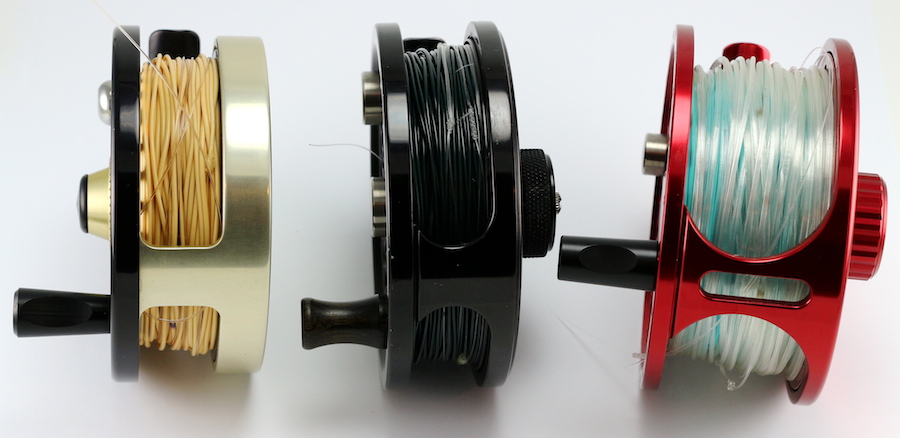
Handles on a few fly reels in the 7-8 weight class . From left to right: the Billy Pate "Salmon", the Abel 3N, and the TFO 375. The handle on the Billy Pate flares wider
at the tip, the one on the Abel is the same diameter at the tip and the base, and the one
on the TFO is narrower at the tip.
Fly reel handles must turn smoothly - I despise ones that don't. Most fly reel handles will require some periodic maintenance and light lubrication to stay in good working order - this is one spot where salt and dirt tends to accumulate easily, resulting in a handle that doesn't turn as smoothly as it should. It should be quite simple to remove and replace the handle for this sort of maintenance. This seems to be the most common maintenance chore that I perform on my own fly reels.
Most good reel handles are made of a very tough plastic. Some (like those on the older model Abel reels) are made of strong hardwoods like rosewood or ebony, and lots of folks like these. Some of the makers are even doing handles made of aluminum these days. I don't like handles that feel too "slippery". I've had at least one reel that had a handle made of a tough, textured "rubbery" feeling material that felt very secure in the grip. Some of the old Orvis Odyssey fly reels had a paddle shaped handle that sure looked different, but was comfortable to grip when retrieving line. Beware of handles made of brittle plastics; these can be broken if it is mistreated (by dropping the reel, or smacking the handle against a rock or other hard object). If you have a reel with a broken handle, and parts are no longer available, give Bill Archuleta a call (link shown below) - he'll make you a new one!
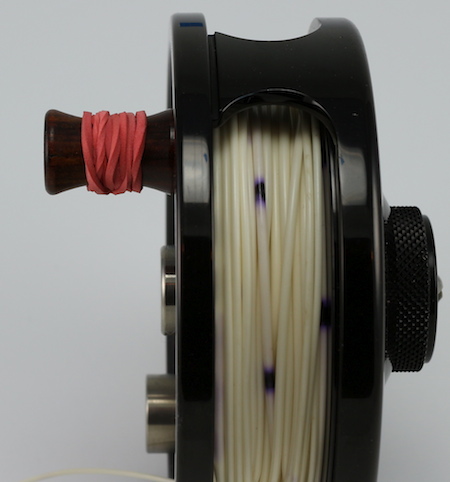
Here's a quick fix for a fly reel handle that's too small, or one that feels slippery - a rubber band wrapped around the handle provides a very positive grip.
Framing the issue
Fly reels are made these days with either what I will refer to as a full frame design or cutaway frame design. Full frame designs feature a backplate, as well as an outer rim.
Cutaway frames have only a backplate, and the outer rim has been cut away which offers a savings in weight. Plenty of reels also feature a backplate that has had significant material cut away, again for a savings in weight, as well as to ventilate the reel to help the line dry between outings. One may assume that a full frame design would be strongest, but there seems to be no real loss of strength in the best classic and modern reels with a rim that has been cut away. The majority of fly reels made today feature a cutaway frame design.
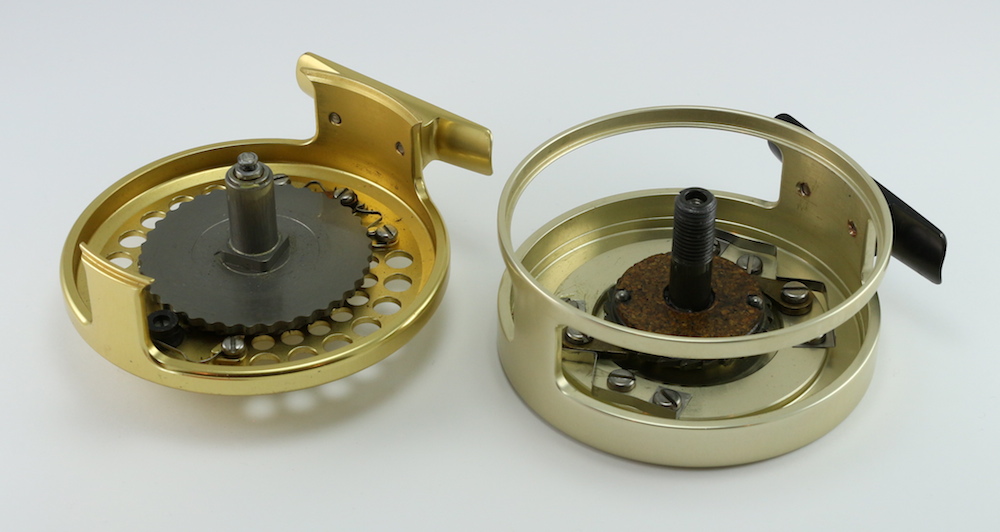
Frame Designs. On the left the Islander LS3 with a "cutaway" frame and vented backplate, and on the right a Billy Pate Salmon featuring a "full frame" and solid backplate.
A practical consideration in choosing a full-frame vs a cutaway design is that spools mounted on full-frame reels cannot easily be removed from the reel without taking the fly off and completely reeling in the line - efforts to do this on enclosed rim designs may result in the line or leader jamming between the spool and the outer part of the frame. Occasionally one may wish to remove the spool with the rod still strung up, and a cutaway frame design makes it very easy to do this.
Getting Spooled
Spools on fly reels are either "exposed rim" (also called raised-rim), or enclosed rim designs. There are still some modern fly reels that are made with enclosed spool rims, but not many. An exposed rim design allows the angler easy access to "palm" the rim to slow the run of the fish if necessary, and therefore provides some extra control. (The same braking effect can be created by pressing a finger against the "cake" of line inside the spool as the line runs out, but this is not as convenient as using an exposed rim). Reels with enclosed rim spools in which the outer edge of the spool is enclosed by a full reel frame are somewhat archaic in my opinion, and this type of design is much less common that it once was. There are some real classics like Billy Pates, Fin-Nors, Pfleuger Medalists, Seamaster, etc. that originally were made with enclosed spool rims, but most of those same reels eventually evolved into models with exposed rims. For practical reasons, I prefer exposed rim designs whenever possible. There are some modern fly reels made to look "retro" that continue to be built in a full frame /enclosed rim style (The Peerless reels, for example), - some of these have been patterned after other classic full frame reels like the Bodgan reel by the late Stan Bogdan.
The size and proportions of the frame and spool are also important, and should be determined by the angler's preference, and type of use that is expected for the reel.
Reels with a large diameter spool will take up line faster, and this can be useful for fast running fish like tunas. Some authors have suggested that a larger spool will help anglers to "keep up" with the run of a fast fish coming towards them. One reel manufacturer recently boasted that their reels were large enough to take up a full foot of line per turn. Tuna species like bluefins and yellowfin can swim at burst speeds of over 40mph - that's just about 60 feet per second. I haven't met the angler yet that can make 60 turns of the reel each second. No reel out there will give you the ability to "keep up" with the run of a truly fast fish rushing directly at the boat, but a large diameter spool will take up line faster than a smaller spool.
Another advantage of a large diameter spool is that the line will have less "memory"
when it comes off the spool - less of a tendency to retain the coiled shape of being on the reel, and more likely to lay flat which makes casting and line management much easier. Fly lines in general exhibit much less memory than they used to due to improvements in manufacturing, but it's still a consideration. These days many reels are fitted with what is specified as a "Large Arbor" spool, which usually refers to a large diameter spool with less capacity than a full depth spool. As the diameter of the spool increases, so does the capacity of line that it can carry, so it's no longer necessary to create a full-depth spool for considerations of line capacity.
Line capacity of the spool is another one of those subjects that is much debated amongst anglers, and a spool must be large enough to hold the necessary amount of line for the situation, but as a general rule, 150 yards of backing will be more than sufficient for general purpose saltwater fly fishing. Bonefish anglers may want 200 yards, but really it would be very rare for any bonefish to run this off. Offshore anglers may want more - up to 600 yards for species like tuna, wahoo, and marlin. Keep in mind that the further a fish gets from you, the less control you have, and if a big fish gets away from the boat, the boat should be moved to give the angler some relief rather than attempting to crank in 500 yards under the pressure of a heavy fish. Modern ultra-thin "gel-spun" or spectra fiber backing or running lines make it easy to get the capacity you need with just about any spool.
Let it be noted here that even given these considerations which would point most anglers towards larger diameter spools, that there are those who feel that the move towards larger and larger spools is less fun for the angler. On reels with smaller diameter spools, the run of the fish can feel more exciting, as a reel with a smaller diameter could be spinning very quickly during the fish's run- as much as twice as fast as a reel with a larger one. (Thanks and a tip of the hat to Dave Skok for pointing this out). Watch your thumbs.
Balancing Act
Now here's an issue that is bound to start a ruckus whenever it's discussed among
experienced saltwater fly anglers. There have been quite a few debates in online forums about this issue, and others may disagree, but I believe that a reel that is heavy enough to provide the proper balance to the whole system makes the job of casting easier. There is a huge trend in reel design to eliminate excess weight, in an attempt to build the lightest possible reels, while still maintaining the strength and integrity of the reel. This is fine to a point, but it is important to realize that the reel still has to balance the weight of the rod. If the reel is too light for the rod, then the rod will not balance properly at the imaginary "fulcrum" which forms when the rod & reel combo is cast by an angler. A reel that is too light may actually make the rod feel heavy or "clunky" in the hand, and possibly even put undue stress on the hand, wrist, or arm of the caster.
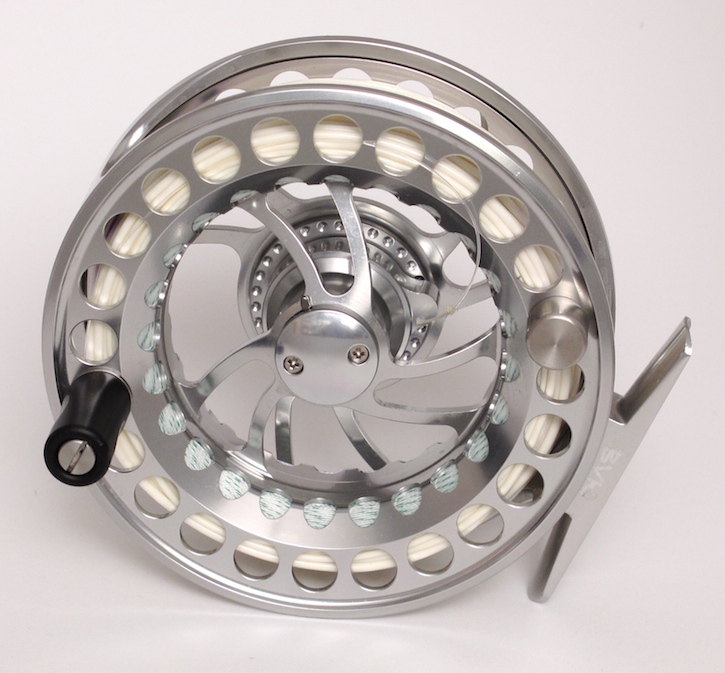
TFO's BVK III - an extremely lightweight modern fly reel. Rated for 8 weight line capacity, this reel weighs just a tad over 5 ounces without the line and backing. This reel didn't feel well balanced on an eight weight rod, but it felt just fine
when matched with a six weight.
Lightweight reels can make a fly outfit feel cumbersome, and I seem to have a harder time developing the proper line speed with them. It is my opinion that a heavier reel, or one that at least balances the rod correctly can actually make it easier to cast, and may help the angler develop better line speed. It has been reported that top tarpon angler Andy Mill matches his 12 weight tarpon rods with the Tibor "Pacific" model. This is one of the largest fly reels ever made, and is usually reserved for tuna and marlin. This large diameter reel will provide a fast retrieve rate, and it is also heavy enough to balance a 12 weight outfit - probably over a pound when fully loaded with line and backing. The reel does provide a significant counterweight to the entire system, especially at the critical moment when the correct length of line is held outside of the rod tip prior to the "shoot" or delivery of the fly to its target. With my own style of casting, I feel that beefier reels help me develop better line speeds. While older, heavier rods call for heavier reels to balance them properly, Newer, lighter rods may balance just fine with lighter reels.
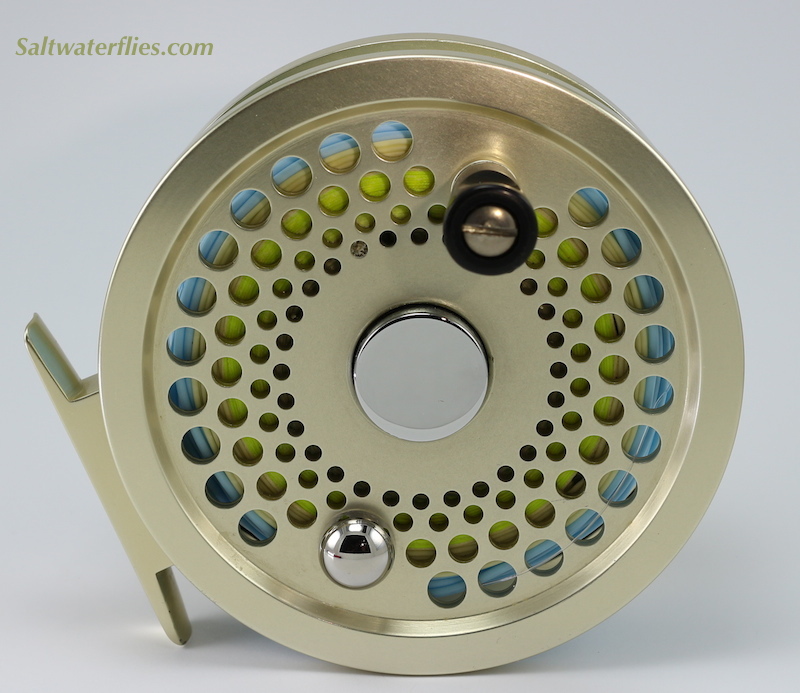
Fin-Nor Ahab 8/10. This beast weighs in at a full 16 ounces spooled with backing and a 10 weight line.
I match this reel with 9, 10, or 11 weight rods for striped bass, tarpon, small tunas, bull reds, big bonefish, and other flats dwellers like shark and barracuda.
Durability & Maintenance - In our next installment, we discuss how to keep a saltwater fly reel in good working order for a long time to come.
-- Chris Windram
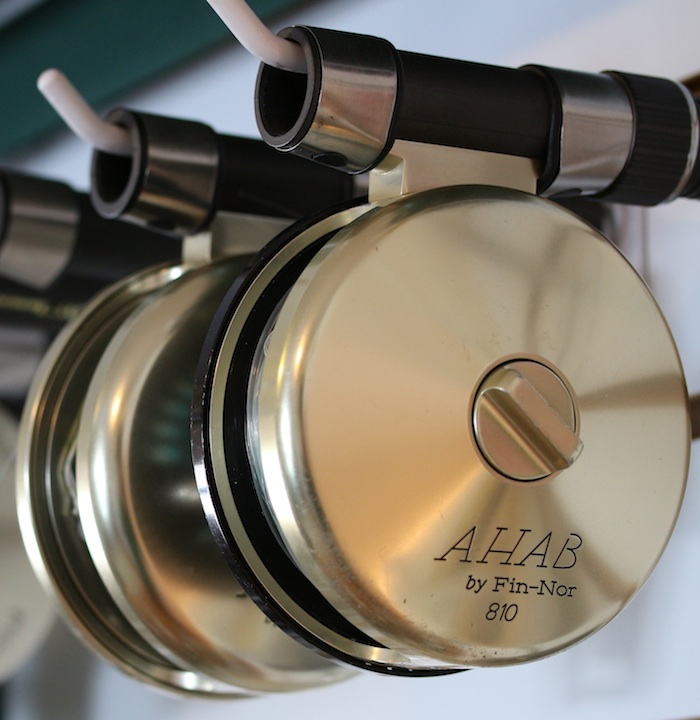
A couple of well-used Fin-Nor Ahab 810's.
Some Links to other sites about saltwater fly reels
https://www.islander.com Islander Reels: beautiful reels made on Vancouver Island, British Columbia, Canada.
https://www.abelreels.com Abel Reels: Classic modern
fly reels made in the USA.
https://www.tiborreel.com Billy Pate and Tibor Fly Reels by Ted Juracsik Tool and Die.
https://www.makoreels.com Mako Reels by Jack Charlton
https://www.codella.com/usedreel.htm Classic, Used & New Fly Reels by Len Codella's Sporting Collectibles
https://www.just-reels.com/index.htm Just Reels from Big Bend, Wisconsin
https://www.cheekyflyfishing.com Cheeky Reels - Diggin' the New at Cheeky Fly Fishing
https://www.vintageflytackle.com/collections/reels Vintage Fly Tackle's page of vintage used fly reels
https://www.archuletasreelworks.com Archuleta's Reel Works - custom reels and repair services by Bill Archuleta, Grants Pass, Oregon
Fly reels aren't a drag for Bill Archuleta - a nice article on Archuleta's Reel Works.
[Wade Back to the Home Page]







